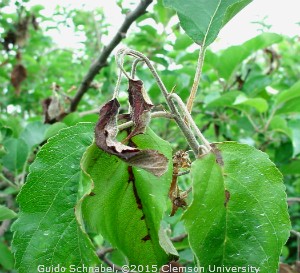Fire Blight
go.ncsu.edu/readext?415858
en Español / em Português
El inglés es el idioma de control de esta página. En la medida en que haya algún conflicto entre la traducción al inglés y la traducción, el inglés prevalece.
Al hacer clic en el enlace de traducción se activa un servicio de traducción gratuito para convertir la página al español. Al igual que con cualquier traducción por Internet, la conversión no es sensible al contexto y puede que no traduzca el texto en su significado original. NC State Extension no garantiza la exactitud del texto traducido. Por favor, tenga en cuenta que algunas aplicaciones y/o servicios pueden no funcionar como se espera cuando se traducen.
Português
Inglês é o idioma de controle desta página. Na medida que haja algum conflito entre o texto original em Inglês e a tradução, o Inglês prevalece.
Ao clicar no link de tradução, um serviço gratuito de tradução será ativado para converter a página para o Português. Como em qualquer tradução pela internet, a conversão não é sensivel ao contexto e pode não ocorrer a tradução para o significado orginal. O serviço de Extensão da Carolina do Norte (NC State Extension) não garante a exatidão do texto traduzido. Por favor, observe que algumas funções ou serviços podem não funcionar como esperado após a tradução.
English
English is the controlling language of this page. To the extent there is any conflict between the English text and the translation, English controls.
Clicking on the translation link activates a free translation service to convert the page to Spanish. As with any Internet translation, the conversion is not context-sensitive and may not translate the text to its original meaning. NC State Extension does not guarantee the accuracy of the translated text. Please note that some applications and/or services may not function as expected when translated.
Collapse ▲ Fire blight is one of the most devastating and difficult to control diseases of fruit trees such as apple and pear. Unfortunately, this spring’s wet, cool weather has been conducive to fire blight. This disease is caused by a bacterium (Erwinia amylovora) that can spread rapidly when environmental conditions are right for disease development.
Fire blight is one of the most devastating and difficult to control diseases of fruit trees such as apple and pear. Unfortunately, this spring’s wet, cool weather has been conducive to fire blight. This disease is caused by a bacterium (Erwinia amylovora) that can spread rapidly when environmental conditions are right for disease development.
The bacteria can enter plants through the flower blossoms or wounds (such as those caused by wind or hail damage). Infected flowers or leaves turn black and die. The disease moves down the branch resulting in the death of young twigs which blacken and curl over. Leaves on affected branches wilt and blacken but remain attached to the branch giving the plant a fire-scorched appearance. If you look closely at the bark, slightly sunken areas called cankers appear on branches and the main stem. Insects and rain can spread the disease from plant to plant.
Fire blight is most commonly seen on apples and pears although other plants such as crabapple, pyracantha, hawthorn, photinia, quince and loquat can also be affected. There is no cure for fire blight so disease prevention is extremely important. When choosing plants, select varieties that are less susceptible to fire blight. Avoid excessive nitrogen fertilization which can result in succulent growth that is susceptible to disease.
Bradford pear (an ornamental pear) is fairly resistant to fire blight. When infected, Bradford pears tend to compartmentalize the disease well losing only inches of branches to the disease in a season. However, these cankers can serve as a reservoir of disease for subsequent seasons. Susceptible varieties of pears and apples can see substantially more damage.
Preventive spraying in early spring with streptomycin or copper based fungicides is possible in a commercial orchard setting. However, for most homeowners the cost and effort is not reasonable. Trees need to be sprayed at a 3 to 4 day interval during bloom and the entire leaf canopy must be treated for control.
You can reduce the spread of fire blight by removing and destroying all affected plant parts after the window for disease development is past. A warm dry period during the summer or during the winter dormant season are good times to prune. Pruning cuts should be made a minimum of 8 to 12 inches below any sign of affected tissue. Dispose of all infected prunings away from the orchard and sanitize pruning shears between cuts. A 10% household bleach solution or Lysol can be used to dip the pruners between cuts and reduce disease transmission. If not pruned out, these cankers will continue to spread the disease in subsequent seasons.



